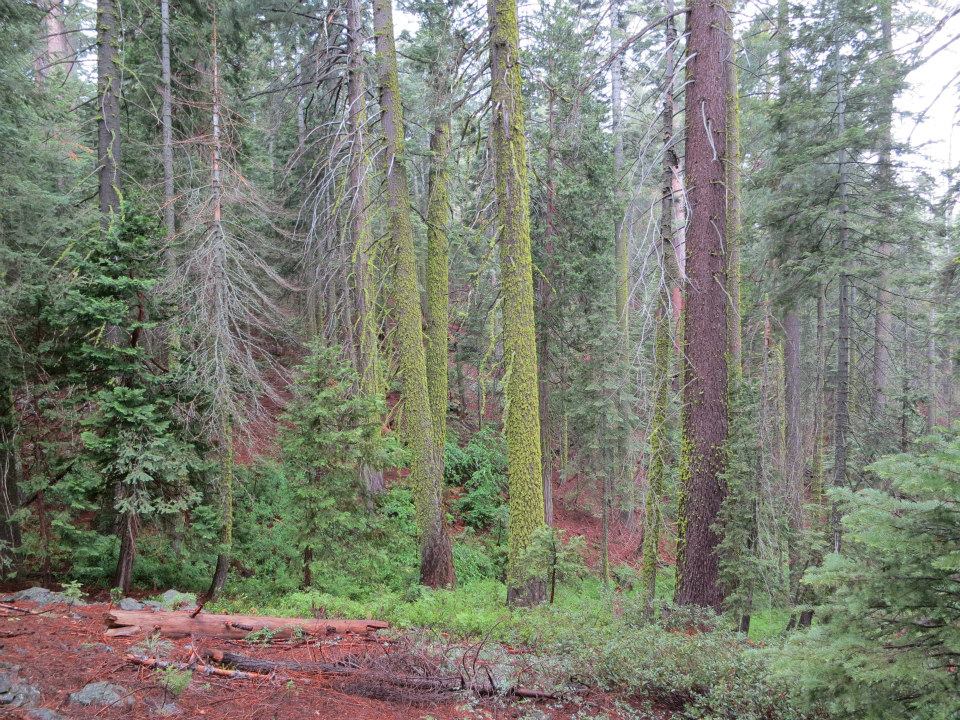Tracking the Lives of Some of the Oldest and Tallest Trees in the World with Jim Lutz

Long term forest plot prior to burn in 2013. Yosemite National Forest. Courtesy: Jim Lutz.
James A. Lutz, Associate Professor at Utah State University was recently highlighted in a BBC news story that documented changes occurring within Yosemite National Park over in the last 10 years.
Lutz initiated a study that began in 2009 to better understand western forests. Mounting evidence suggests that forests are changing in the west, from decreased density in Yosemite’s forests, to an increase in California fires, tree mortality rates are rising. To better understand these changes, plots have been designated in partnership with the Smithsonian Institution ForestGEO as research sites where long-term studies can take place to track the changes in these forests over time.
The Yosemite Forest Dynamics Plot (YFDP) spans 2.5 ha and is located in Yosemite National Park. It is the largest permanently monitored plot in the National Parks System. Each tree in the plot has been mapped and is revisited and monitored each year to try and piece together it’s unique story. By meticulously recording the state of each tree, over time they are able to assess growth as well as tree mortality over time.
BBC has been involved in this study since the beginning. This most recent coverage aired in June 2019 during the network’s prime news slot and was the top streamed video for more than 24 hours. News reporter Peter Bowes covered the story in 2009, and 10 years later Bowes and his team came back to follow- up on the project. Revisiting the same trees that they had the first time, they discussed changes that the forest has undergone, especially the impacts of a fire the forest experienced in 2013.
A prescribed fire had always been in the plan for the plot, but the 2013 fire is was a backfire that was lit to help control the massive Rim Fire that the park was experiencing. A backfire is a fire that is set to halt the advance of (or redirect) a wildfire. The goal of a backfire is to consume fuel (vegetation) that would otherwise be in the path of a wildfire. Because researchers had always known there would be a fire in the park, they were not particularly distraught that their plot was burned. In most cases data is collected after a fire but scientists rarely have the opportunity to so closely compare the composition of the forest before and after the fire as they were able to in this case.
When asked about his findings so far, Lutz said “It’s never just one thing that kills a tree”. While the fire certainly contributed to killing many of the small trees, big trees took longer to die for a combination of reasons. Post-fire, the plot experienced two drought years and a beetle outbreak of a few different native beetles. These pressures successfully killed many bigger trees.
Lutz added that one thing which often goes underrated when talking about the death of a tree is mechanical mortality (when large trees fall and damage/crush nearby small trees). Small trees are obviously more vulnerable and susceptible to damage. His team’s findings suggest this impact is larger than Lutz may have originally presumed.
The YFDP is just one of three plots which Lutz is working on. There is also the Wind River Forest Dynamics Plot located in Gifford Pinchot National Forest in Washington and the Utah Forest Dynamics Plot in Cedar Breaks National Monument. The characteristics of each forest is different and they are in varying climates surrounded by diverse species. This allows for scientists to better understand forests in the West as a whole by considering these differing factors
This type of long-term research will exceed Lutzs ’ career and likely that of many of his graduate students. This is important because it allows scientists to understand more about forests than they could with other short-term methods. Lutz has many future questions he hopes to answer with these plots, for example he would like to understand if one tree species is more vulnerable to mortality than another. He also hopes to understand how the mortality of specific trees impact the forest as a whole. He is hopeful the BBC will continue to follow this story in the future and report on their findings so that the public can know what is going on in their forests.
All photos courtesy Jim Lutz








